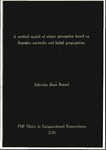A cortical model of object perception based on Bayesian networks and belief propagation.
| dc.contributor.supervisor | Denham, Susan L | |
| dc.contributor.author | Durá-Bernal, Salvador | |
| dc.contributor.other | Faculty of Science and Engineering | en_US |
| dc.date.accessioned | 2011-08-19T11:48:32Z | |
| dc.date.available | 2011-08-19T11:48:32Z | |
| dc.date.issued | 2011 | |
| dc.date.issued | 2011 | |
| dc.identifier | 10080717 | en_US |
| dc.identifier.uri | http://hdl.handle.net/10026.1/540 | |
| dc.description.abstract |
Evidence suggests that high-level feedback plays an important role in visual perception by shaping the response in lower cortical levels (Sillito et al. 2006, Angelucci and Bullier 2003, Bullier 2001, Harrison et al. 2007). A notable example of this is reflected by the retinotopic activation of V1 and V2 neurons in response to illusory contours, such as Kanizsa figures, which has been reported in numerous studies (Maertens et al. 2008, Seghier and Vuilleumier 2006, Halgren et al. 2003, Lee 2003, Lee and Nguyen 2001). The illusory contour activity emerges first in lateral occipital cortex (LOC), then in V2 and finally in V1, strongly suggesting that the response is driven by feedback connections. Generative models and Bayesian belief propagation have been suggested to provide a theoretical framework that can account for feedback connectivity, explain psychophysical and physiological results, and map well onto the hierarchical distributed cortical connectivity (Friston and Kiebel 2009, Dayan et al. 1995, Knill and Richards 1996, Geisler and Kersten 2002, Yuille and Kersten 2006, Deneve 2008a, George and Hawkins 2009, Lee and Mumford 2003, Rao 2006, Litvak and Ullman 2009, Steimer et al. 2009). The present study explores the role of feedback in object perception, taking as a starting point the HMAX model, a biologically inspired hierarchical model of object recognition (Riesenhuber and Poggio 1999, Serre et al. 2007b), and extending it to include feedback connectivity. A Bayesian network that captures the structure and properties of the HMAX model is developed, replacing the classical deterministic view with a probabilistic interpretation. The proposed model approximates the selectivity and invariance operations of the HMAX model using the belief propagation algorithm. Hence, the model not only achieves successful feedforward recognition invariant to position and size, but is also able to reproduce modulatory effects of higher-level feedback, such as illusory contour completion, attention and mental imagery. Overall, the model provides a biophysiologically plausible interpretation, based on state-of-theart probabilistic approaches and supported by current experimental evidence, of the interaction between top-down global feedback and bottom-up local evidence in the context of hierarchical object perception. | en_US |
| dc.language.iso | en | en_US |
| dc.publisher | University of Plymouth | en_US |
| dc.subject | Bayesian networks | en_US |
| dc.subject | Belief propagation | en_US |
| dc.subject | Hierarchical object perception | en_US |
| dc.subject | Visual cortex | en_US |
| dc.subject | Visual perception | en_US |
| dc.subject | Feedback connections | en_US |
| dc.subject | Object Recognition | en_US |
| dc.title | A cortical model of object perception based on Bayesian networks and belief propagation. | en_US |
| dc.type | Thesis | |
| dc.identifier.doi | http://dx.doi.org/10.24382/4598 |
Files in this item
This item appears in the following Collection(s)
-
01 Research Theses Main Collection
Research Theses Main


